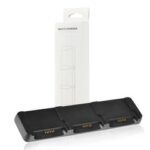VCDS (Vag-Com Diagnostic System) offers powerful diagnostic capabilities for Volkswagen Audi Group (VAG) vehicles, including injector testing. By examining specific measuring blocks, technicians can assess injector balance and fuel usage to pinpoint potential issues. This article delves into using VCDS to test injectors, focusing on interpreting data from measuring blocks 13 and 15.
Using VCDS Measuring Blocks for Injector Analysis
VCDS allows access to engine module measuring blocks, providing valuable data on various engine parameters. For injector diagnostics, blocks 13 and 15 are particularly relevant. Block 13 displays idle balance, indicating the contribution of each injector to maintaining a smooth idle. Block 15 shows fuel usage in liters per hour, reflecting the overall fuel consumption of the engine.
Analyzing these blocks can reveal imbalances between injectors, excessive fuel consumption, or other potential problems. Ideally, all injectors should contribute equally to idle stability (Block 13) and fuel consumption should fall within the manufacturer’s specified range (Block 15).
Injector Wear and Pop Pressure: Impact on VCDS Readings
Injector wear, particularly diminished pop pressure, significantly affects the reliability of VCDS readings. The pilot pop pressure, ideally around 220 bar (3250 psi), often drops to around 170 bar with wear, representing a substantial pressure loss. Similarly, the main stage pressure (NoP2), typically near 300 bar (4350 psi), can also decrease.
These pressure deviations impact injector performance and, consequently, the data displayed in VCDS measuring blocks. Injectors operating outside their optimal pressure range may exhibit misleading balance readings in Block 13. In such cases, relying solely on Block 13 data for diagnosis can be inaccurate.
Limitations of VCDS for Testing Worn Injectors
While VCDS provides valuable insights into injector performance, its effectiveness in diagnosing worn injectors is limited. When injectors have significant wear and diminished pop pressures, Block 13 data becomes less reliable. Injectors may appear balanced even with underlying issues.
Thorough injector testing, including pop pressure measurement and spray pattern analysis, is crucial for accurate diagnosis in these situations. Attempting to diagnose worn injectors solely based on VCDS data can lead to misdiagnosis and ineffective repairs.
When VCDS Data is Most Useful
VCDS injector testing is most effective when evaluating relatively new injectors or injectors with minimal wear. In these cases, Block 13 and 15 data can accurately reflect injector balance and fuel usage. This information can help identify faulty injectors, confirm the proper functioning of new injectors, and ensure optimal engine performance. However, for high-mileage injectors with suspected wear, comprehensive testing beyond VCDS is necessary.
Conclusion: VCDS as a Tool in Injector Diagnostics
VCDS serves as a valuable tool in diagnosing injector issues, particularly when analyzing injector balance and fuel usage in relatively new or well-maintained injectors. However, its effectiveness diminishes with worn injectors due to the impact of decreased pop pressure on VCDS readings. In cases of suspected injector wear, comprehensive testing, including pop pressure measurement, is essential for accurate diagnosis and effective repair. Relying solely on “Test Injectors Vcds” readings in these scenarios may not provide a complete picture of injector health.

